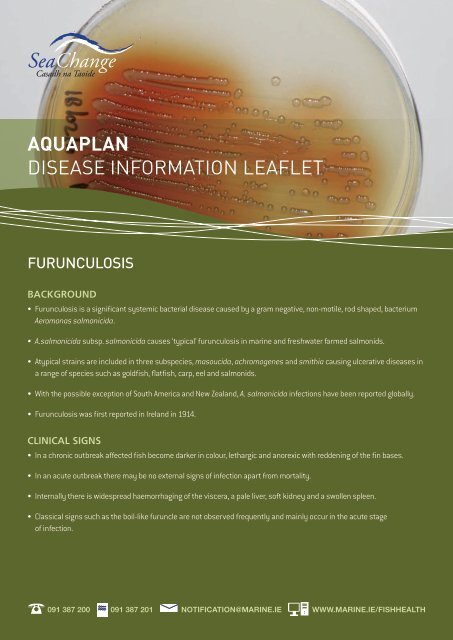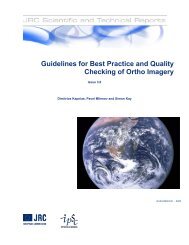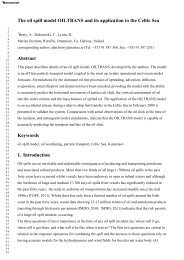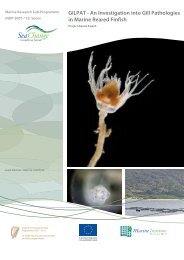Download disease information leaflet on furunculosis - Marine Institute
Download disease information leaflet on furunculosis - Marine Institute
Download disease information leaflet on furunculosis - Marine Institute
You also want an ePaper? Increase the reach of your titles
YUMPU automatically turns print PDFs into web optimized ePapers that Google loves.
SeaChange<br />
Casadh na Taoide<br />
AQUAPLAN<br />
DISEASE INFORMATION LEAFLET<br />
FURUNCULOSIS<br />
BACKGROUND<br />
• Furunculosis is a significant systemic bacterial <str<strong>on</strong>g>disease</str<strong>on</strong>g> caused by a gram negative, n<strong>on</strong>-motile, rod shaped, bacterium<br />
Aerom<strong>on</strong>as salm<strong>on</strong>icida.<br />
• A.salm<strong>on</strong>icida subsp. salm<strong>on</strong>icida causes ‘typical’ <strong>furunculosis</strong> in marine and freshwater farmed salm<strong>on</strong>ids.<br />
• Atypical strains are included in three subspecies, masoucida, achromogenes and smithia causing ulcerative <str<strong>on</strong>g>disease</str<strong>on</strong>g>s in<br />
a range of species such as goldfish, flatfish, carp, eel and salm<strong>on</strong>ids.<br />
• With the possible excepti<strong>on</strong> of South America and New Zealand, A. salm<strong>on</strong>icida infecti<strong>on</strong>s have been reported globally.<br />
• Furunculosis was first reported in Ireland in 1914.<br />
CLINICAL SIGNS<br />
• In a chr<strong>on</strong>ic outbreak affected fish become darker in colour, lethargic and anorexic with reddening of the fin bases.<br />
• In an acute outbreak there may be no external signs of infecti<strong>on</strong> apart from mortality.<br />
• Internally there is widespread haemorrhaging of the viscera, a pale liver, soft kidney and a swollen spleen.<br />
• Classical signs such as the boil-like furuncle are not observed frequently and mainly occur in the acute stage<br />
of infecti<strong>on</strong>.<br />
091 387 200 091 387 201<br />
notificati<strong>on</strong>@marine.ie www.marine.ie/fishhealth
DIAGNOSIS<br />
• Histopathological examinati<strong>on</strong> reveals col<strong>on</strong>ies of bacteria in many organs including the heart, kidney and spleen.<br />
• Culture of the pathogen <strong>on</strong> suitable culture medium results in small, circular, raised col<strong>on</strong>ies of A. salm<strong>on</strong>icida,<br />
which often produce a brown diffusing pigment.<br />
• Culture of the pathogen should be followed by antibiotic sensitivity testing.<br />
CONTROL<br />
• Horiz<strong>on</strong>tal transmissi<strong>on</strong> (through the water and infected fish) and the presence of asymptomatic carriers,<br />
play important roles in the spread of the <str<strong>on</strong>g>disease</str<strong>on</strong>g>.<br />
• Vaccinati<strong>on</strong> is an effective form of c<strong>on</strong>trol, but unvaccinated stocks remain vulnerable where the water supply<br />
c<strong>on</strong>tains wild fish. There are several commercially produced vaccines available.<br />
• Antibiotic treatment is effective, although resistance is observed and sensitivity testing is required.<br />
(All antibiotic treatment requires veterinary supervisi<strong>on</strong> and a prescripti<strong>on</strong>).<br />
WHAT SHOULD I DO?<br />
• Minimise potentially stressful procedures such as handling and grading when <strong>furunculosis</strong> is suspected<br />
or c<strong>on</strong>firmed.<br />
• As <strong>furunculosis</strong> is not listed under Council Directive 2006/88/EC, c<strong>on</strong>trol of the <str<strong>on</strong>g>disease</str<strong>on</strong>g> is a matter for the operator<br />
and the retained veterinary practiti<strong>on</strong>er.<br />
• Strict biosecurity measures should be implemented around the infected site.<br />
• Remove moribund and dead fish from infected pens/tanks daily. Mortalities should be disposed of in accordance<br />
with current Animal By-Products Regulati<strong>on</strong>s.<br />
• If the vet notices a change in the nature of the infecti<strong>on</strong> and suspects a more virulent <str<strong>on</strong>g>disease</str<strong>on</strong>g> is emerging or<br />
alternatively, if the <str<strong>on</strong>g>disease</str<strong>on</strong>g> is suspected in a new host species, you should c<strong>on</strong>tact the Fish Health Unit of the<br />
<strong>Marine</strong> <strong>Institute</strong>. If you suspect the presence of a listed <str<strong>on</strong>g>disease</str<strong>on</strong>g> you should also notify the <strong>Marine</strong> <strong>Institute</strong>.<br />
AquaPlan (Grant-Aid Agreement No. PBA/AF/08/003(01)) is carried out under the Sea Change strategy with the support of the <strong>Marine</strong> <strong>Institute</strong> and the <strong>Marine</strong> Research<br />
Sub-Programme of the Nati<strong>on</strong>al Development Plan 2007-2013, co-financed under the European Development Fund.<br />
For as na Mara<br />
Vet-Aqua Internati<strong>on</strong>al<br />
EUROPEAN REGIONAL<br />
DEVELOPMENT FUND<br />
Photographs © <strong>Marine</strong> <strong>Institute</strong> & Vet Aqua Internati<strong>on</strong>al.

















